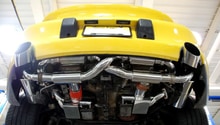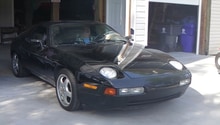Porsche 928: Signs of a Bad Catalytic Converter
The failure of a vehicle's catalytic converter can be accompanied by a nauseating exhaust odor, or a noisy exhaust rattle. Additionally, a cat failure is typically the result of a engine related issue that has destroyed or reduced cat efficiency over a period of time.
This article applies to the Porsche 928 (1978-1995).
A catalytic converter is a component of the exhaust system that reduces or eliminates exhaust emissions by way of a chemical reaction. The factory catalytic converters installed on Porsche 928 models are very robust, and meant to last the life of the vehicle. When a catalytic converter prematurely fails, it is often due to an engine maintenance related issue. Whether the catalytic converter has become melted, plugged, or contaminated, it should be replaced and an engine tune-up performed to ensure the new catalytic converter does not suffer the same fate as its predecessor. This article will examine the symptoms of a bad catalytic converter, and the potential issues that can cause them to fail.

Materials Needed
- Floor jack and jack stands
- Rubber mallet
- Vacuum gauge
- Metric sockets and wrenches (for exhaust removal)
Symptoms of catalytic converter failure can include:
- A rattling sound emanating from the catalytic converter.
- A poor engine performance.
- A high NOx, CO, and HC emissions.
- A strong sulfur or rotten egg smell.
If your catalytic converter has failed, it may be worthwhile to inspect various engine components to ensure proper performance before installing a new cat. See the Related Article: Why Is My Car Losing Power?
Step 1 – Rattling
While a catalytic converter typically has to be removed to inspect its condition, a rattling sound from the cat is an indication that the inner honeycomb assembly has broken loose, and is no longer secured in the piping. A rattle can be present at idle, under load, or under deceleration. The easiest way to ensure the catalytic converter is the culprit is to simply tap on it with a rubber mallet (or a closed fist), and listen for a rattle. This particular form of failure can be the result of physical damage or thermal shock. If the car has run over road debris or collided with other objects, the cat can be physically damaged. The cat can also suffer from thermal shock if, at operating temperature, it is quickly cooled by running over snow, or a large pool of water. This is most common on 928s that are driven year-round. While a cat may rattle and still function, it can eventually fracture as well as clog the exhaust to the point where engine performance will severely suffer.
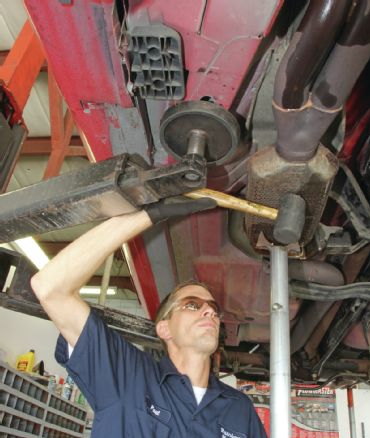
Step 2 – Thermal failure (melted)
A common type of catalytic converter failure often has to do with the cat becoming overheated, and eventually melting. Thermal failure (or melting) is caused by raw fuel making its way into the cat. Catalytic converters operate at very high temperatures to clean exhaust emissions; however, when raw fuel comes in contact with the cat, the fuel burns in the converter and overheats the cat. When overheated, the ceramic honeycomb will melt and plug the exhaust path. The result is often a loss of performance, or an engine that will not rev freely. While the catalytic converter usually has to be removed and inspected to see this problem, an overheated cat can display heat discoloration that will be visible from the outside.
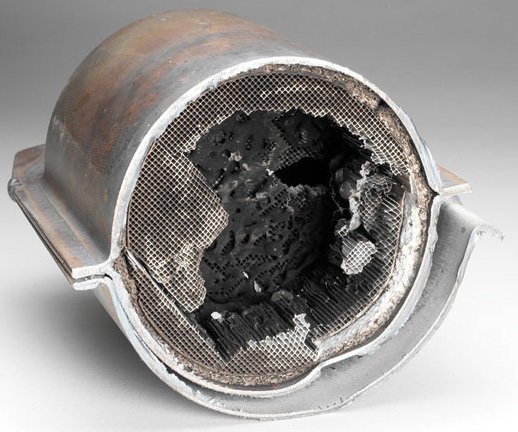
Figure 2. Catalyst meltdown. 
Figure 3. Examples of heat discoloration.
Pro Tip
The ceramic honeycomb can melt to the point where it is no longer secured in the catalytic converter housing, and can also exhibit a rattling noise.
Warning
Porsche 928 models equipped with dual ignition circuits (two distributors) can experience an ignition circuit failure where half of the cylinders will stop firing, and raw fuel will be dumped into the exhaust system. Although Porsche put a safeguard in place to stop fuel flow to allow the 1989 and newer cars to enter limp-home mode, previous model years can very quickly overheat the catalytic converters, which will catch on fire if driven with a failed ignition circuit. If you believe your car has an ignition circuit failure, do not attempt to drive it any further because injury and serious damage can occur!
Step 3 – Clogged catalyst
A vehicle with a clogged catalytic converter will usually exhibit poor performance issues especially at cruising or highway speeds. Similar to fuel starvation symptoms, a 928 with a clogged cat may idle fine, but lack performance under acceleration. Additionally, the increased exhaust back pressure can cause the engine to run hotter than normal, and may be misdiagnosed as a cooling system problem. Either way, accumulation of carbon buildup in the catalytic converter is often due to cylinder combustion inefficiency, and should be inspected before a new cat is installed.
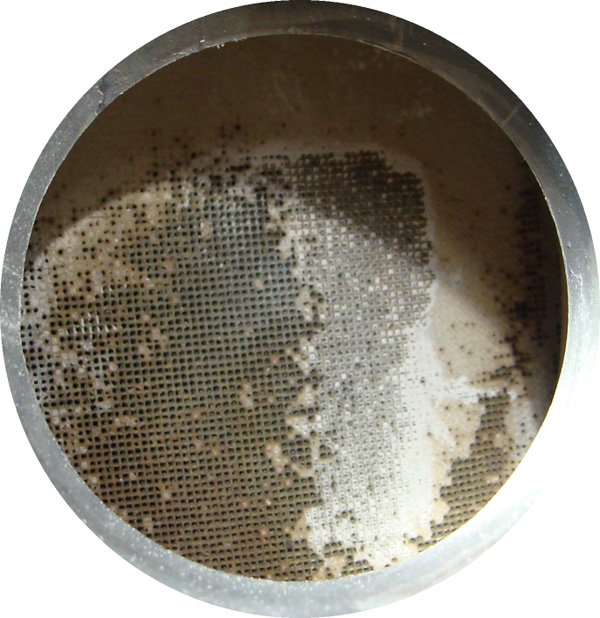
Pro Tip
The easiest way to check for a plugged catalytic converted is to measure vacuum at the intake manifold with the engine running. With the engine at idle, vacuum should measure between 18 to 22 Hg. Additionally, if the throttle is blipped and held at 3,000 rpm, vacuum should temporarily drop before stabilizing. If vacuum drops or remains low, excessive back pressure is present in the exhaust system, and the cat is likely plugged.
Step 4 – Contamination
While not as common as other catalytic converter failures, the internal leaking of engine oil or coolant leak can damage a catalytic converter. Whether it be worn valve guides or worn piston rings, oil that makes its way into the cylinder—and finally downstream to the catalytic converter—will coat the reactive surface of the ceramic honeycomb, causing its efficiency to suffer. Similarly, engine coolant is harmful to the operation of the catalytic converter as the silicates in the coolant prevent the chemical reactions in the cat from occurring. If you are experiencing white or blue smoke out of the exhaust pipe, it is a telltale sign of coolant or oil entering the cylinders, and the problem needs to be addressed to prevent engine damage.

Related Discussions
- Why Does My Car Smell So Bad? - Rennlist.com
- Catalytic Converter Clogged - Rennlist.com
- Cat Rattles When Pounded with Fist - Rennlist.com

